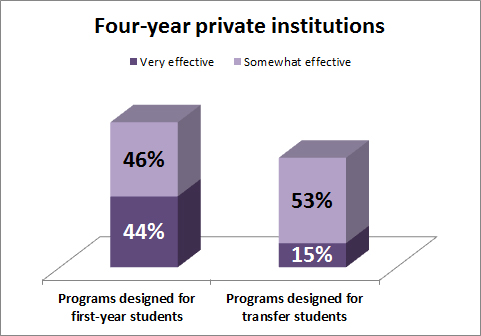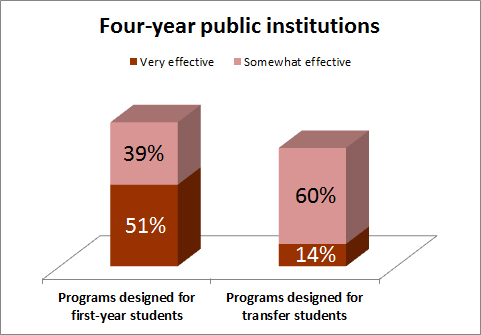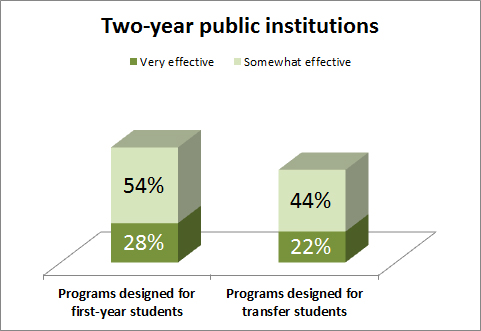student success
Campus officials rate retention programs for college transfer students less effective than first-year student retention programs
Many in higher education are zeroing in on improving college completion rates among transfer students—a growing undergraduate subpopulation on campuses of all types. Yet data from our latest research study shown above indicate that retention programming for transfer students lags behind when compared with first-year student retention programs.
For example, 44 percent of the four-year private institution respondents in the study rated their first-year student programs “very effective” on a rating scale that used a four-part scale: “very effective,” “somewhat effective,” “minimally effective,” and “method not used.” Yet just 15 percent of these same respondents rated their transfer student programs “very effective.” Respondents from four-year public institutions and two-year public institutions also gave lower ratings to transfer student programs.
Our 2013 Report: The Attitudes and Motivations of College Transfer Students offers insights into a range of “non-cognitive” attitudes that influence transfer students’ motivation, engagement, persistence, and college completion. It is based on student survey responses from a sizable sample of transfer students at four-year and two-year institutions. The data show the transition to a new campus for a transfer student is not always easy. In addition to learning a new set of policies and procedures, some students may feel frustrated if some of their previously earned credits did not transfer (see page 18 of the report). They may regret not seeking assistance or services at their previous institution and wonder if these will be available. Some may feel disconnected and confused by the unknown.
How can college transfer students get a strong start in a new academic environment?
Academic success is often affected by a student’s willingness to accept assistance provided by the institution. When asked if they would like to receive assistance, nearly half of the transfer students in the attitudinal study indicated receptivity to academic support services. For example, among the respondents from four-year public institutions, 50 percent indicated they would like tutoring. (The comparable figure for respondents from four-year private institutions was 48 percent and, for two-year public institution respondents, 37 percent.) The survey also asked whether the students had received tutoring assistance at their previous institution. Across institution types, less than 24 percent reported receiving tutoring previously.
The study confirmed advising is a priority for transfer students. Across institution types, the most substantial difference between students’ previous use of a particular service and students’ receptivity to that same service going forward was in an advising function: students’ desire to prepare a written academic plan for graduation. Among the respondents from four-year public institutions, 62 percent indicated they would like to receive this type of assistance while only 26 percent of those students received the assistance previously. For four-year private institutions, 59 percent of the respondents wanted this type of assistance; 27 percent received the assistance previously. At two-year public institutions, half of the respondents wanted this type of assistance while a quarter received it previously.
The survey also looked at institutional impressions on a seven-point scale ranging from 1 = very dissatisfied to 7 = very satisfied. Transfer students in the study appeared to be somewhat dissatisfied with their frequency of communication with academic advisors, rating it relatively low at 4.83 overall.
How might your students compare?
7-point checklist for retaining college transfer students
Understanding transfer students’ attitudes, receptivity, motivations, and level of satisfaction with services is important in supporting their needs. The key is to tailor student success programs to these needs. Below are ideas to consider.
Does your institution offer:
1. Orientation programs tailored specifically for transfer students, including segments that address concerns such as transfer of credit, finances, major-related internships, and meaningful work experiences?
2. Programs beyond the usual classroom and advising services that connect transfer students to faculty, staff, and native students within academic or co-curricular interest areas?
3. Peer mentors for transfer students?
4. Assignment of students to an advisor within the student’s major/area of interest with an early focus on confirming or further refining a written academic plan?
5. An advising center devoted to transfer students?
6. Career fairs for students who are undecided about a major?
7. Academic support services based on areas of student need and receptivity?
To discuss ways to increase transfer student retention on your campus, e-mail me and I will share strategies that are working at other institutions. Also, if you’re attending CSRDE’s 2013 National Symposium on Student Retention, November 3-6, in San Diego, be sure to come to my session focused on transfer student retention and stop by our exhibit booth.


